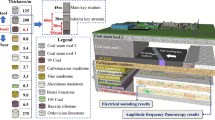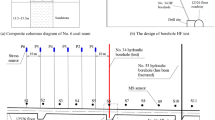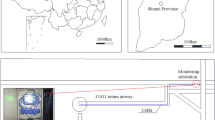Abstract
Differences are found in the attributes of microseismic events caused by coal seam rupture, underground structure activation, and groundwater movement in coal mine production. Based on these differences, accurate classification and analysis of microseismic events are important for the water inrush warning of the coal mine working face floor. Cluster analysis, which classifies samples according to data similarity, has remarkable advantages in nonlinear classification. A water inrush early warning method for coal mine floors is proposed in this paper. First, the short time average over long time average (STA/LTA) method is used to identify effective events from continuous microseismic records to realize the identification of microseismic events in coal mines. Then, ten attributes of microseismic events are extracted, and cluster analysis is conducted in the attribute domain to realize unsupervised classification of microseismic events. Clustering results of synthetic and field data demonstrate the effectiveness of the proposed method. The analysis of field data clustering results shows that the first kind of events with time change rules is of considerable importance to the early warning of water inrush from the coal mine working face floor.
Similar content being viewed by others
References
Akaike, H., 1969, Power spectrum estimation through autoregressive model fitting: Annals of the Institute of Statistical Mathematics, 21, 407–419.
Akram, J., and Eaton, D. W., 2016, A review and appraisal of arrival time picking methods for downhole microseismic data: Geophysics, 81(2), 71–91.
Albright, J., and Pearson, C., 1982, Acoustic emissions as a tool for hydraulic fracture location: experience at the Fenton hill hot dry rock site: Society of Petroleum Engineers Journal, 22, 523–530.
Allen, R., 1982, Automatic phase pickers: Their present use and future prospects: Bulletin of the Seismological Society of America, 72 (6B), S225–S242.
Arrowsmith, S. J. and Eisner, L., 2006, A technique for identifying microseismic multiples and application to the Valhall field, North Sea: Geophysics, 71(2), 31–40.
Aster, R. C., Shearer, P. M., and Berger, J., 1990, Quantitative measurements of shear wave polarizations at the Anza Seismic Network, southern California: Implications for shear wave splitting and earthquake prediction: Journal of Geophysical Research, 95(B8), 12449–12473.
Atkinson, G. M., Eaton, D. W., Ghofrani, H., Walker, D., Cheadle, B., Schultz, R., Shcherbakov, R., Tiampo, K., Gu, J., Harrington, R. M., Liu, Y. J., van der Baan, M., and Kao, H., 2016, Hydraulic Fracturing and Seismicity in the Western Canada Sedimentary Basin: Seismological Research Letters, 87(3), 631–647.
Baig, A., and Urbancic, T., 2010, Microseismic moment tensors: a path to understanding frac growth: Leading Edge, 29(3), 320–324.
Bao, X., and Eaton, D. W., 2016, Fault activation by hydraulic fracturing in western Canada: Science, 354(6318), 1406–1409.
Chen, H. C., Meng X., Niu, F. L., and Tang Y. C., 2018, Microseismic monitoring of stimulating shale gas reservoir in SW China: 2. Spatial clustering controlled by the preexisting faults and fractures: Journal of Geophysical Research, 123(2), 1659–1672.
Cheng, G. W., Wang Y., Ma T. H., Tang, C. A., Chen, T., and Ma, K., 2017, Research on the partitioning method of the overburden in coal mine based on microseismic monitoring: Chinese Journal of Rock Mechanics and Engineering, 36(S2), 4036–4046.
De Meersman, K., Kendall, J. M. and van der Baan, M., 2009, The 1998 Valhall microseismicity: an integrated study of relocated sources, seismic multiplets and S-wave splitting: Geophysics, 74(5), 183–195.
Diehl, T., Deichmann, N., Kissling, E., and Husen, S., 2009, Automatic S-Wave Picker for Local Earthquake Tomography: Bulletin of the Seismological Society of America, 99 (3), 1906–1920.
Fu, J. H., Wang, X., Li Z. T., Tan, Q., and Wang J. J., 2019, Automatic picking up earthquake’s P waves using signal-to-noise ratio under a strong noise environment: Chinese Journal of Geophysics (in Chinese), 62(4), 1405–1412.
Gao, J. B, Liu, F. Y., Zhang J. F., Hu, J, and Cao, Y. H., 2013, Information entropy as a basic building block of complexity theory: Entropy, 15(9), 3396–3418
Geller, R. J., and Mueller, C. S., 1980, Four similar earthquakes in central California: Geophysical Research Letters, 7(10), 821–824.
Ge, M. C., 2005, Efficient mine microseismic monitoring: International Journal of Coal Geology, 64(8), 44–56.
Gibbons, S. J., and Ringdal, F., 2006, The detection of low magnitude seismic events using array-based waveform correlation: Geophysical Journal International, 165(1), 149–166.
Hardy, H. R., 2003, Acoustic Emission/Microseismic Activity, Principles, Techniques and Geotechnical Applications, Volume 1.A.A: Balkema Publishers, Amsterdam, Netherlands.
Huang, W. L., Wang, R. Q., Li, H. J., and Chen, Y. K., 2017, Unveiling the signals from extremely noisy microseismic data for high-resolution hydraulic fracturing monitoring: Scientific Reports, 7, 11996.
Huang, W. L., 2019, Seismic signal recognition by unsupervised machine learning: Geophysical Journal International, 219(2), 1163–1180.
Jia, J. 2017, Application research on microseismic monitoring technology in coalmine water control: Coal and Chemical Industry, 40(1), 16–20.
Jiang, F. X., Miao X. H., and Wang, C. W., 2010, Predicting research and practice of tectonic-controlled coal burst by microseismic monitoring: Journal of China Coal Society, 35(6), 900–904.
Kapetanidis, V., and Papadimitriou, P., 2011, Estimation of arrival times in intense seismic sequences using a Master-Events methodology based on waveform similarity: Geophysical Journal International, 187(2), 889–917.
Kaufman, L., and Rousseeuw, P., 1990, Finding groups in data: an introduction to cluster analysis: Wiley, New York, USA.
Leonard, M., 2000, Comparison of manual and automatic onset time picking: Bulletin of the Seismological Society of America, 90 (6), 1384–1390.
Li, D. X., Wang, E. Y., Kong, X. G., Ali, M., and Wang, D. M., 2019, Mechanical behaviors and acoustic emission fractal characteristics of coal specimens with a pre-existing flaw of various inclinations under uniaxial compression: International Journal of Rock Mechanics and Mining Sciences, 116, 38–51.
Li, D. X., Wang, E. Y., Li, Z. H., Ju, Y. Q., Wang, D. M., and Wang, X. Y., 2021, Experimental investigations of pressure stimulated currents from stressed sandstone used as precursors to rock fracture: International Journal of Rock Mechanics and Mining Sciences, 145, 104841.
Li, H. J., Wang, R. Q., Cao, S. Y., Chen, Y. K., and Huang, W. L., 2016, A method for low-frequency noise suppression based on mathematical morphology in microseismic monitoring: Geophysics, 81, V159–V167.
Li, J., Yu, B. S., Tian, Y.K. Kang, H. X., Wang, Y. F., and Zhou, H., 2020, Effect analysis of borehole microseismic monitoring technology on shale gas fracturing in western Hubei: Applied Geophysics, 17, 764–775.
Liu, J. P., Si, Y. T., Zhang, C. Y., and Wang R., 2020, Estimation of fracturing mechanisms by the ratio of radiated energy between S and P waves of microseismic events during mining in metal mines: Applied Geophysics, 17, 465–474.
Liu, L, Song, W. Q., Zeng, C., and Yang, X. H., 2021, Microseismic event detection and classification based on convolutional neural network: Journal of Applied Geophysics, 192(6), 104380.
Maxwell, S. C., Rutledge, J., Jones, R., and Fehler, M., 2010, Petroleum reservoir characterization using downhole microseismic monitoring: Geophysics, 75(5), 129–137.
Mendel, J. M., 1991, Tutorial on higher-order statistics (spectra) in signal processing and system theory: theoretical results and some applications: Proceedings of the IEEE, 79(3), 278–305.
Mousavi, S. M., and Langston, C. A., 2016, Hybrid Seismic Denoising Using Higher-Order Statistics and Improved Wavelet Block Thresholding: Bulletin of the Seismological Society of America, 106(4), 1380–1393.
Mousavi, S. M., Horton, S. P., Langston, C. A., and Samei, B., 2016, Seismic features and automatic discrimination of deep and shallow induced-microearthquakes using neural network and logistic regression: Geophysical Journal International, 207(1), 29–46.
Peng, Z. G. and Ben-Zion, Y., 2005, Spatiotemporal variations of crustal anisotropy from similar events in aftershocks of the 1999 M7.4 İzmit and M7.1 Düzce, Turkey, earthquake sequences: Geophysical Journal International, 160, 1027–1043.
Phillips, W. S., Fairbanks, T. D., Rutledge, J. T., and Anderson, D. W., 1998, Induced microearthquake patterns and oil-producing fracture systems in the Austin chalk: Tectonophysics, 289(1–3), 153–169.
Rowe, C. A., Aster, R. C., Phillips, W. S., et al., 2002, Using automated, high precision repicking to improve delineation of microseismic structures at the Soultz geothermal reservoir: Pure and Applied Geophysics, 159(1), 563–596.
Rutledge, J. T., Phillips W. S., and Mayerhofer, M. J., 2004, Faulting induced by forced fluid injection and fluid flow forced by faulting: an interpretation of hydraulic fracture microseismicity, Carthage Cotton Valley gas field, Texas: Bulletin of the Seismological Society of America, 94(5), 1817–1830.
Shang G. J., Huang W. L., Yuan L. K., Shen J. S., Gao F., and Zhao L. S., 2022, Automatic microseismic events detection using morphological multiscale top-hat transformation: Petroleum Science, 19(5), 2027–2045.
Shannon, C. E., 1948, A mathematical theory of communication: The Bell System Technical Journal, 27(3), 379–423.
Song, F., Kuleli, H. S., ToksöZ, M. N., Ay, E., and Zhang, H., 2010, An improved method for hydrofracture-induced microseismic event detection and phase picking: Geophysics, 75(6), A47–A52.
Torra, V., and Narukawa, Y., 2012, On a comparison between Mahalanobis distance and Choquet integral: The Choquet-Mahalanobis operator: Information Sciences, 190, 56–63.
Tselentis, G-Akis, Martakis, N., Paraskevopoulos, P., Lois, A., and Sokos, E., 2012, Strategy for automated analysis of passive microseismic data based on S-transform, Otsu’s thresholding, and higher order statistics: Geophysics, 77, KS43–KS54.
Wang, Y. J., Wang, L. J., Li, K. H., Liu, Y., Luo, X. Z., and Xing, K., 2020, Unsupervised seismic facies analysis using sparse representation spectral clustering: Applied Geophysics, 17(4), 533–543.
Young, P. R., 1993, Rockbursts and Seismicity in Mines 93: Proceedings of the 3rd international symposium, 16–18 August 1993, Ontario, Canada, 23–50.
Yu, Z. C., Yu, J., Feng, F. F., Tan, Y. Y., Hou, G.T., and He, C., 2020, Arrival picking method for microseismic phases based on curve fitting: Applied Geophysics, 17(3), 453–464.
Zhang, X. L., Jia, R. S., Lu, X. M., Peng, Y. J., and Zhao, W. D., 2018, Identification of blasting vibration and coal-rock fracturing microseismic signals: Applied Geophysics, 15, 280–289.
Zhang, Z., Xu, Y., Yang, J., Li, X. L., and Zhang, D., 2015, A Survey of Sparse Representation: Algorithms and Applications: IEEE Access, 3, 490–530.
Zhou, C., Ju, X. G., Li, Z. A., and Liu, X. M., 2020, A deep convolutional generative adversarial network for first-arrival pickup from seis-mic data: Geophysical Prospecting for Petroleum, 59(5), 795–803.
Acknowledgments
This work was supported in part by the National Natural Science Foundation of China under Grant 41904098, in part by the Beijing Nova Program under Grant 2022056, and in part by the National Natural Science Foundation of China (52174218).
Author information
Authors and Affiliations
Corresponding author
Additional information
Shang Guo-Jun is a postdoctoral fellow at China University of Mining and Technology. He graduated from China University of Petroleum (Beijing) in 2012 with a bachelor’s degree in Exploration Technology and Engineering. He studied at China University of Petroleum (Beijing) from 2016 to 2022 and obtained his Ph.D. degree in Geological Resources and Geological Engineering in 2022. He is currently engaged in post-doctoral research at the School of Safety, China University of Mining and Technology. His main research interest is mining engineering safety and science.
Huang Wei-Lin is a Professor at China University of Petroleum (Beijing). He studied at China University of Petroleum (Beijing) from 2016 to 2022 and obtained his double bachelor’s, master’s and Ph.D. degrees. He is currently engaged in teaching and research at the College of Geophysics, China University of Petroleum (Beijing). His main research interests include seismic signal processing, analysis and inversion, artificial intelligence and big data, microseismic monitoring, and image and signal processing.
Rights and permissions
About this article
Cite this article
Shang, GJ., Liu, XF., Li, L. et al. Cluster analysis of the domain of microseismic event attributes for floor water inrush warning in the working face. Appl. Geophys. 19, 409–423 (2022). https://doi.org/10.1007/s11770-022-0952-4
Received:
Revised:
Published:
Issue Date:
DOI: https://doi.org/10.1007/s11770-022-0952-4




